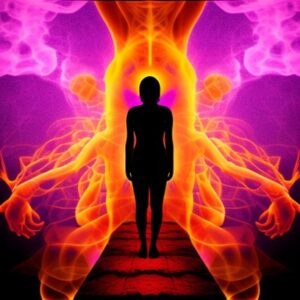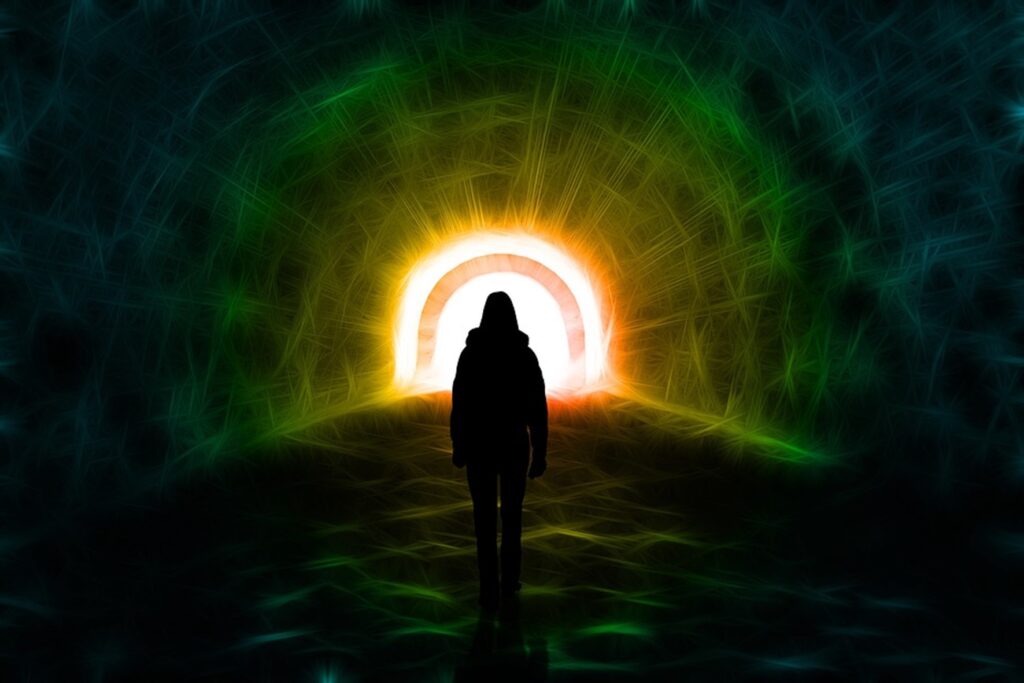By Saulo Silvestre and Mariana Meneses

Image generated using Picsart AI text-to-image generator.
Near-death experiences (NDEs) are profound personal experiences sometimes triggered during life-threatening episodes.
You may have heard of NDE reports involving, for example, seeing a bright light at the end of a tunnel or people leaving their bodies and floating above them.
Events like these have been reported in several cultures throughout history, inspiring much speculation and many interpretations. While the uniqueness of NDEs is at least partially responsible for the remarkable persistence of mysticism surrounding the experiences, this is also related to our limited understanding of the phenomenon.
These curious and often-reportedly life-changing experiences often last less than an hour, yet may permanently change the minds of those who undergo NDEs. NDEs are so intensely and lucidly recalled that they can feel, to the people who experience them, even more real than conscious reality itself. People who had NDEs often report radical transformations, such as no longer fearing death, detachment from material possessions, and the re-orientation of self towards the greater good.
Further, individuals have portrayed these powerful experiences as being unconstrained by space or time. They are often described as pain-free out-of-body experiences that can include meeting spiritual beings and seeing a collection of lifetime memories.
However, even though NDEs are often portrayed as positive, they can sometimes be very negative.
Indeed, many experiencers (especially those selected to appear in the media) do generally describe their memories as peaceful and divine, reporting feelings of oneness with the universe, but some report feelings such as terror, anguish, and loneliness. Some researchers suspect that this type of experience might be underreported due to factors such as shame, social stigma, and pressure to conform to societal expectations of what people should experience in these episodes.

Some report near-death experiences as the vision of light at the end of a tunnel. Image: Max Pixel
NDEs were seen as confabulations or hallucinations before they became a field of empirical study around the turn of the 21st century, when researchers began to investigate patterns connecting near-death accounts.
But these episodes present an intrinsic challenge to the scientific investigation: their occurrence can hardly be predicted or controlled. NDEs do not wait to happen until the individual is inside a magnetic scanner, with fully mapped brain activity. Furthermore, it is difficult to determine the underlying neurological sequence of events in an NDE, since there are many ways in which the brain can be damaged.
Even so, as usual, scientists have been trying to find ways around these challenges. For example, some studies focus on specific events with the potential to trigger NDEs, like cardiac arrests followed by cardiopulmonary resuscitations. In other cases, scientists may try to trigger NDEs themselves. Centrifuges, like those used in the training of astronauts, can be used in these studies, since multiplying the force of gravity can interrupt the flow of blood to the brain, leading individuals to faint and possibly engage in NDE-like episodes. In the future, scientists might even study NDEs in lab mice.
Despite all the challenges, research on NDEs has been growing in recent years.
But when it comes to their relationship to human consciousness, we may still be far from complete answers, as this particular field remains understudied. This is what Dr. Charlotte Martial and colleagues argue, in a 2020 study published in the journal Trends in Cognitive Science. Human consciousness is so overwhelmingly complex that they believe these studies should approach consciousness in parts, by distinguishing between what they call wakefulness, connectedness, and internal awareness.
Wakefulness: “spontaneous or stimulus-induced eye opening”. Connectedness: “the connection to the external world allowing the experience of external stimuli, either in a state of wakefulness or non‐wakefulness”; Internal awareness: “all environmental stimulus-independent thoughts (e.g., mental imagery, inner speech, mind wandering)” Martial et al. (2020).

Illustration of out-of-the-body experience. Image: Louish Pixel
Neurologists have empirically shown that NDEs can also be induced by epileptic seizures.
By electrically stimulating patients’ brains, researchers found that specific epileptic events that are restricted to one brain hemisphere create effects very similar to NDEs. These seizures can impair consciousness and may be accompanied by depersonalization, déjà vu, ecstatic feelings, and/or impaired perceptions of sizes, tastes, smells, and bodily feelings.
Besides brain electrical stimulation, NDEs can also be triggered by psychoactive substances, specifically hallucinogens linked to the neurotransmitter serotonin, which include magic mushrooms (psilocybin), LSD, and DMT. Patients usually report a blissful experience, enhanced well-being, and better self-awareness, from either psychoactive substances or electrical stimulation on the brain. Scientists believe that the connections between NDEs and the material brain provide support for a biological reason – instead of a mystical one – behind these incredible events.
In line with this reasoning, some studies began to look for possible individual-level correlates of NDEs.
The idea is that, if there are traits that make us more prone to NDEs, this should count as evidence that they are created and depend on our brains. With that in mind, Dr. Martial and colleagues looked for individual-level characteristics that might impact NDEs. They discovered a potential connection between fantasy proneness and reporting these experiences. However, this is not necessarily a causal relationship, so whether this proneness leads to increased chances of having NDEs, or if the relationship between these traits results from the influence of other unknown variables, is still an open question.

Hallucination zooming effect. Image: Libreshot
Regardless of this and many other unanswered questions surrounding the theme, we already know that an NDE is the tale of a dying brain.
When the material house of the human consciousness stops receiving blood and oxygen, the electrical activity in the cortex is turned off and the person faints. From there, brain regions stop working one at a time. The mind, limited to the remaining neurons still capable of electrical activity, constructs a story based on the person’s memories, which include cultural expectations. For example, the often reported “light at the end of the tunnel” may be no more than the progressive decay of peripheral vision, as the blood flow is reduced and narrows vision to what experiencers call the “tunnel”.
The increasingly accepted scientific interpretation of NDEs is that the brain starts to shut down as the blood and oxygen flow stop, and in this process, it creates many distorted stories based on images and meanings arising from reduced information available. Until the person returns to life, the mind and consciousness vanish completely as the body prepares for death. As if rebooting a computer, upon regaining consciousness, the brain’s continuing narrative is resumed.
Dr. Martial told The Quantum Record that “This paper aimed to establish a novel framework of consciousness to understand the episodes of NDE, as well as its associated state of consciousness. This new framework may facilitate the development of a more nuanced scientific description of NDEs, as well as the empirical study of the phenomenon.”
But among all the unanswered questions around the triggers and physiological mechanisms behind NDEs, there is one mystery that seems particularly hard to solve: given the inherent will to life of our brains, why are NDEs not predominantly panic-inducing and frightening events? Why would our brains struggle to sustain a blissful and peaceful sensation in the face of the imminent collapse?
Since this publication, Dr. Martial has worked with colleagues in various follow-up studies, aiming to understand better the phenomenon of NDE.
One of them explored the idea that near-death experiences might have a biological origin and purpose. The researchers investigated a defense mechanism called thanatosis, or death-feigning, which is used by animals as a last-resort survival strategy. They found that it is a common strategy across various species, including humans. Humans who are under attack from animals, other humans, or modern threats can experience both thanatosis and near-death experiences.
The researchers discovered that the two phenomena have similar characteristics and effects, and suggested that they serve the purpose of enhancing survival. The researchers propose that the development of language in humans enabled the transformation of these experiences from basic survival responses into the rich perceptions that we associate with near-death experiences, extending beyond predatory situations.
Another very recent study of Dr. Martial and colleagues, that has just been released in May 2023, looked at out-of-body experiences, where people feel like they are outside their physical bodies.
The researchers used virtual reality to create similar experiences and studied the brain activity of 7 participants. The participants reported feeling like they were floating in the air and high up in the virtual room, but only a weak to moderate feeling of being outside their bodies. The analysis of the participants’ brain activity showed changes in certain brain waves, including an increase in delta and a decrease in alpha waves. Delta waves are associated with deep sleep and unconscious states, while alpha waves are linked to relaxed and idle mental states. These changes suggest that the participants’ brain activity shifted towards a state resembling deep sleep or unconsciousness during the virtual out-of-body experiences.
While near-death experiences (NDEs) have long been shrouded in mysticism and spiritual beliefs, scientific research has played a crucial role in unveiling the physiological mechanisms that give rise to these extraordinary encounters. This growing body of scientific knowledge challenges traditional interpretations and offers a deeper understanding of NDEs as intricate phenomena that can be explored through empirical research.
Looking for more fascinating reads?
Don’t forget to explore other TQR articles, like,
- The Science of Consciousness: Have We Finally Solved the Mystery Inside Our Heads?,
- The Surprising Connection Between Human Bodies and Supernova Explosions
- What’s In the Middle of Black Holes, and Why Do We Care?



